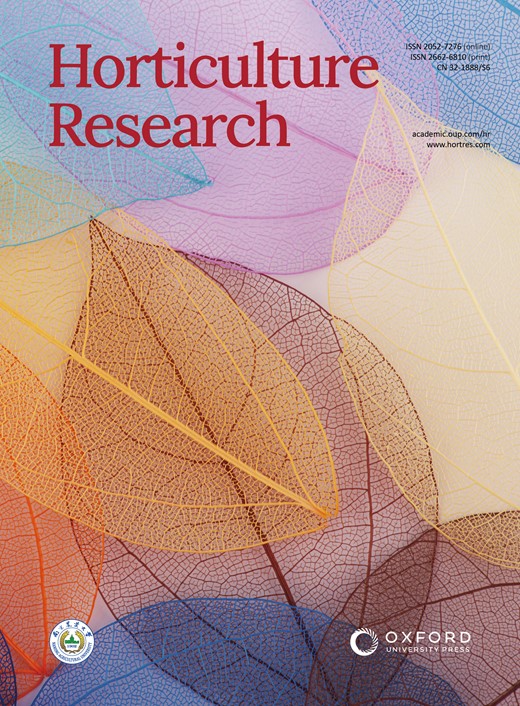葡萄浆果甲基组揭示了与成熟代谢相关的组织特异性特征
IF 8.5
1区 农林科学
Q1 Agricultural and Biological Sciences
引用次数: 0
摘要
DNA甲基化是植物发育过程中重要的表观遗传调控因子,但其在葡萄果实成熟过程中的作用尚不清楚。在这里,我们分析了两个品种“Wink”和“Cabernet Sauvignon”在发育阶段和组织(皮肤和牙髓组织)的全基因组DNA甲基化景观,揭示了成熟过程中广泛存在的DNA超甲基化。我们观察到在成熟过程中,跨转座元件、基因体和邻近区域的整体DNA甲基化逐渐增加,特别是在CHH背景下。这种高甲基化在两个品种中都是保守的,并且在皮肤和牙髓组织中都很明显。差异甲基化区(DMRs)揭示了组织特异性甲基化模式,皮肤和牙髓表现出明显的高甲基化动力学。进一步的分析表明,这些组织特异性的高甲基化动力学部分归因于早期发育阶段皮肤和牙髓之间预先存在的甲基化差异。功能分析表明,DNA甲基化抑制剂(zebularine和RG108)在体外延迟了浆果成熟,强调了甲基化在这一过程中的关键作用。此外,RNA-seq分析确定了与差异甲基化相关的组织特异性基因表达变化,特别是在花青素生物合成、果糖代谢和糖酵解等代谢途径中。值得注意的是,花青素代谢相关基因的组织特异性高甲基化与其表达模式相关,这表明DNA甲基化在成熟过程中代谢物积累中具有调节作用。总的来说,这些发现强调了DNA甲基化作为一个关键的调控层,在葡萄成熟过程中协调组织特异性基因表达和代谢变化,从而促进了我们对果实发育表观遗传控制的理解。本文章由计算机程序翻译,如有差异,请以英文原文为准。
The grape berry methylome reveals tissue-specific features associated with metabolism in ripening
DNA methylation is a critical epigenetic regulator in plant development, yet its role in grape berry ripening remains poorly understood. Here, we profiled the genome-wide DNA methylation landscapes of two cultivars, ‘Wink’ and ‘Cabernet Sauvignon’, across developmental stages and tissues (skin and pulp tissues), revealing widespread DNA hypermethylation during ripening. We observed a progressive increase in global DNA methylation, particularly in the CHH context, across transposable elements, gene bodies, and adjacent regions during ripening. This hypermethylation was conserved across both varieties and was pronounced in both skin and pulp tissues. Differentially methylated regions (DMRs) revealed tissue-specific methylation patterns, with skin and pulp exhibiting distinct hypermethylation dynamics. Further analysis demonstrated that these tissue-specific hypermethylation dynamics are partially attributable to pre-existing methylation differences between skin and pulp at earlier developmental stages. Functional analysis demonstrated that DNA methylation inhibitors (zebularine and RG108) delayed berry ripening in vitro, underscoring the critical role of methylation in this process. Furthermore, RNA-seq analysis identified tissue-specific gene expression changes associated with differential methylation, particularly in metabolic pathways such as anthocyanin biosynthesis, fructose metabolism, and glycolysis. Notably, tissue-specific hypermethylation of genes involved in anthocyanin metabolism correlated with their expression patterns, suggesting a regulatory role for DNA methylation in metabolite accumulation during ripening. Collectively, these findings underscore DNA methylation as a critical regulatory layer that orchestrates tissue-specific gene expression with metabolic shifts during grape maturation, thereby advancing our understanding of epigenetic control in fruit development.
求助全文
通过发布文献求助,成功后即可免费获取论文全文。
去求助
来源期刊

Horticulture Research
Biochemistry, Genetics and Molecular Biology-Biochemistry
CiteScore
11.20
自引率
6.90%
发文量
367
审稿时长
20 weeks
期刊介绍:
Horticulture Research, an open access journal affiliated with Nanjing Agricultural University, has achieved the prestigious ranking of number one in the Horticulture category of the Journal Citation Reports ™ from Clarivate, 2022. As a leading publication in the field, the journal is dedicated to disseminating original research articles, comprehensive reviews, insightful perspectives, thought-provoking comments, and valuable correspondence articles and letters to the editor. Its scope encompasses all vital aspects of horticultural plants and disciplines, such as biotechnology, breeding, cellular and molecular biology, evolution, genetics, inter-species interactions, physiology, and the origination and domestication of crops.
 求助内容:
求助内容: 应助结果提醒方式:
应助结果提醒方式:


